oil pressure SAAB 9-5 2003 Owners Manual
[x] Cancel search | Manufacturer: SAAB, Model Year: 2003, Model line: 9-5, Model: SAAB 9-5 2003Pages: 288, PDF Size: 16.78 MB
Page 8 of 288
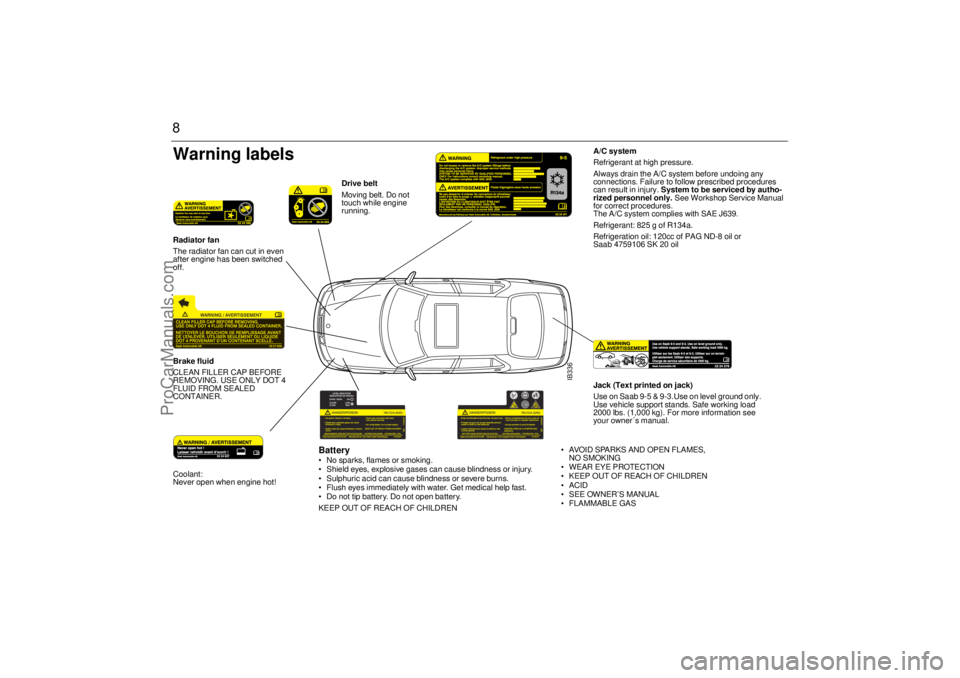
8
Battery No sparks, flames or smoking.
Shield eyes, explosive gases can cause blindness or injury.
Sulphuric acid can cause blindness or severe burns.
Flush eyes immediately with water. Get medical help fast.
Do not tip battery. Do not open battery.
KEEP OUT OF REACH OF CHILDREN Brake fluid
CLEAN FILLER CAP BEFORE
REMOVING. USE ONLY DOT 4
FLUID FROM SEALED
CONTAINER. Radiator fan
The radiator fan can cut in even
after engine has been switched
off.
IB336
Drive belt
Moving belt. Do not
touch while engine
running.
A/C system
Refrigerant at high pressure.
Always drain the A/C system before undoing any
connections. Failure to follow prescribed procedures
can result in injury. System to be serviced by autho-
rized personnel only. See Workshop Service Manual
for correct procedures.
The A/C system complies with SAE J639.
Refrigerant: 825 g of R134a.
Refrigeration oil: 120cc of PAG ND-8 oil or
Saab 4759106 SK 20 oil
Warning labels
AVOID SPARKS AND OPEN FLAMES,
NO SMOKING
WEAR EYE PROTECTION
KEEP OUT OF REACH OF CHILDREN
ACID
SEE OWNER’S MANUAL
FLAMMABLE GAS
Coolant:
Never open when engine hot!Jack (Text printed on jack)
Use on Saab 9-5 & 9-3.Use on level ground only.
Use vehicle support stands. Safe working load
2000 lbs. (1,000 kg). For more information see
your owner´s manual.
ProCarManuals.com
Page 10 of 288

10
No sparks,
flames or
smoking.Buckle up
Use protective
gogglesAirbag
Keep out of
reach of
children.Electric
windows
Battery acid
contains
sulphuric acid.Central
locking
Refer to the
Owner’s
Manual.Never place a
rear-facing
child seat in
this seat.
Risk of
explosive gas.
HeadlightsWindshield
wipers
Direction
indicatorsWindshield
washers
Parking lights Defroster
Hazard
warning lightsRear window
heating
Front fog
lightsVentilation fan
Rear fog lights
Coolant
temperatureRadiator fan
Battery
chargingFuel
Foot brake
Coolant level
Engine oil
pressure
ABS brakes
Examples of symbols that can be found in your car
ProCarManuals.com
Page 56 of 288
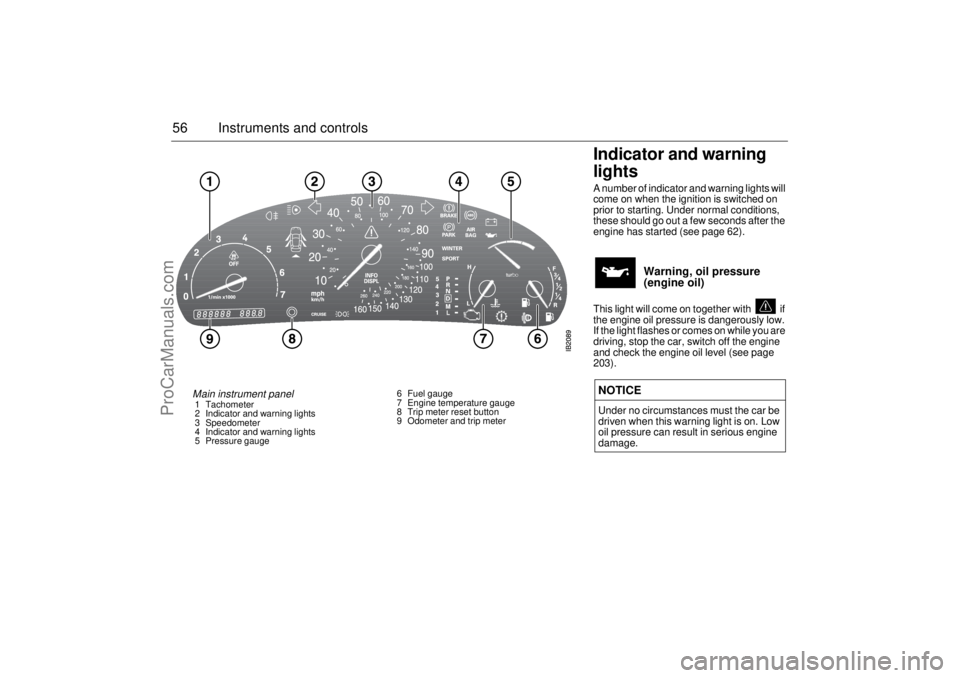
56 Instruments and controls
Indicator and warning
lights A number of indicator and warning lights will
come on when the ignition is switched on
prior to starting. Under normal conditions,
these should go out a few seconds after the
engine has started (see page 62).
Warning, oil pressure
(engine oil)
This light will come on together with if
the engine oil pressure is dangerously low.
If the light flashes or comes on while you are
driving, stop the car, switch off the engine
and check the engine oil level (see page
203). NOTICEUnder no circumstances must the car be
driven when this warning light is on. Low
oil pressure can result in serious engine
damage.
Main instrument panel 1 Tachometer
2 Indicator and warning lights
3 Speedometer
4 Indicator and warning lights
5 Pressure gauge6 Fuel gauge
7 Engine temperature gauge
8 Trip meter reset button
9 Odometer and trip meter
ProCarManuals.com
Page 59 of 288
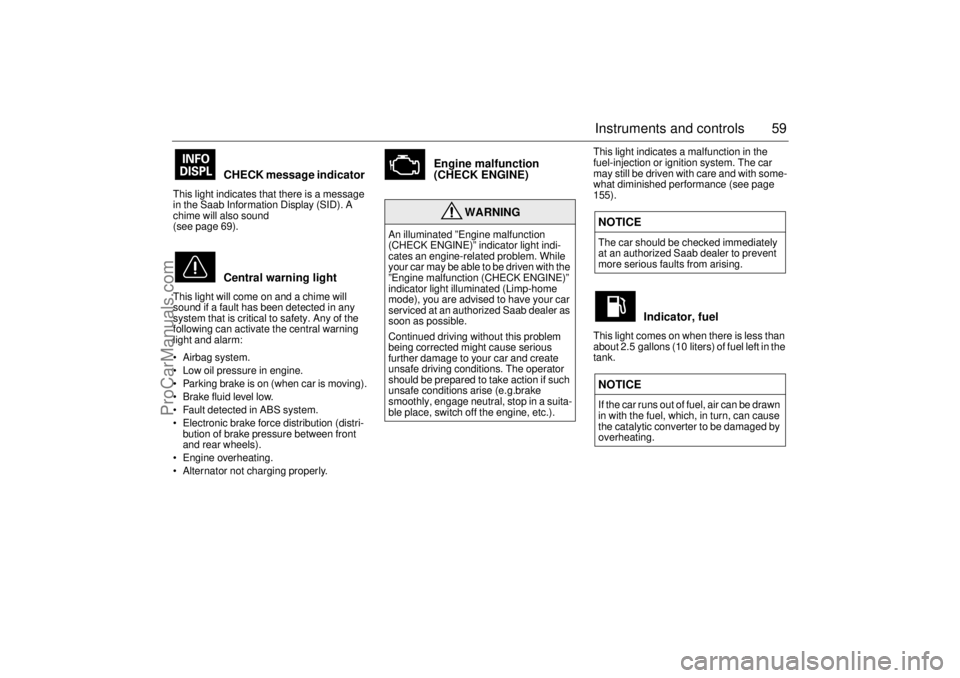
59 Instruments and controls
CHECK message indicator
This light indicates that there is a message
in the Saab Information Display (SID). A
chime will also sound
(see page 69).
Central warning light
This light will come on and a chime will
sound if a fault has been detected in any
system that is critical to safety. Any of the
following can activate the central warning
light and alarm:
Airbag system.
Low oil pressure in engine.
Parking brake is on (when car is moving).
Brake fluid level low.
Fault detected in ABS system.
Electronic brake force distribution (distri-
bution of brake pressure between front
and rear wheels).
Engine overheating.
Alternator not charging properly.
Engine malfunction
(CHECK ENGINE)
This light indicates a malfunction in the
fuel-injection or ignition system. The car
may still be driven with care and with some-
what diminished performance (see page
155).
Indicator, fuel
This light comes on when there is less than
about 2.5 gallons (10 liters) of fuel left in the
tank.
WARNING
An illuminated ”Engine malfunction
(CHECK ENGINE)” indicator light indi-
cates an engine-related problem. While
your car may be able to be driven with the
”Engine malfunction (CHECK ENGINE)”
indicator light illuminated (Limp-home
mode), you are advised to have your car
serviced at an authorized Saab dealer as
soon as possible.
Continued driving without this problem
being corrected might cause serious
further damage to your car and create
unsafe driving conditions. The operator
should be prepared to take action if such
unsafe conditions arise (e.g.brake
smoothly, engage neutral, stop in a suita-
ble place, switch off the engine, etc.).
NOTICEThe car should be checked immediately
at an authorized Saab dealer to prevent
more serious faults from arising.NOTICEIf the car runs out of fuel, air can be drawn
in with the fuel, which, in turn, can cause
the catalytic converter to be damaged by
overheating.
ProCarManuals.com
Page 62 of 288
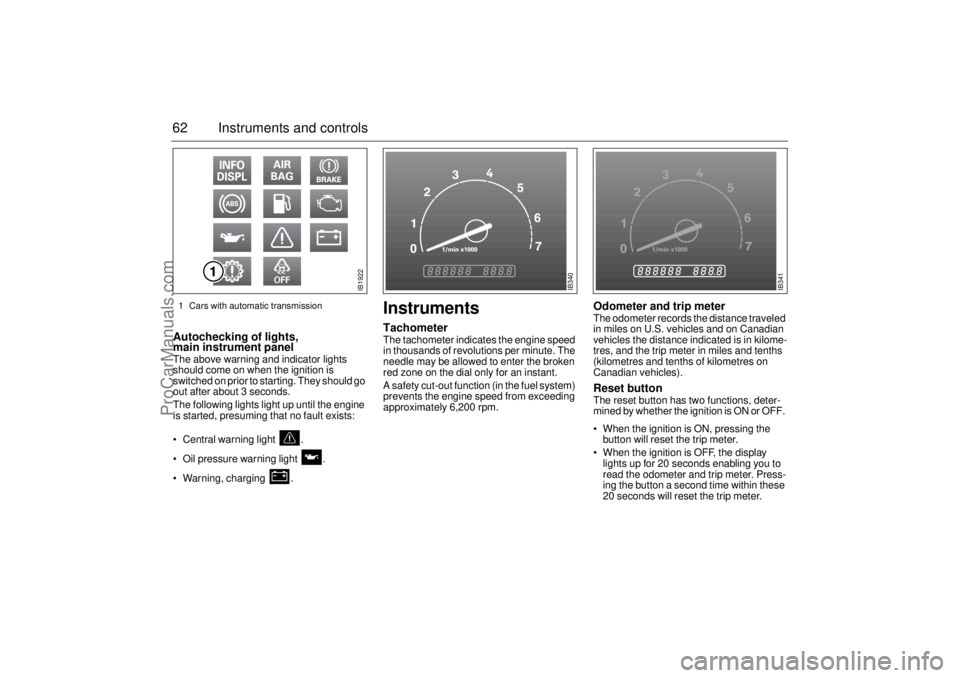
62 Instruments and controlsAutochecking of lights,
main instrument panel The above warning and indicator lights
should come on when the ignition is
switched on prior to starting. They should go
out after about 3 seconds.
The following lights light up until the engine
is started, presuming that no fault exists:
Central warning light .
Oil pressure warning light .
Warning, charging .
InstrumentsTachometerThe tachometer indicates the engine speed
in thousands of revolutions per minute. The
needle may be allowed to enter the broken
red zone on the dial only for an instant.
A safety cut-out function (in the fuel system)
prevents the engine speed from exceeding
approximately 6,200 rpm.
Odometer and trip meter The odometer records the distance traveled
in miles on U.S. vehicles and on Canadian
vehicles the distance indicated is in kilome-
tres, and the trip meter in miles and tenths
(kilometres and tenths of kilometres on
Canadian vehicles). Reset button The reset button has two functions, deter-
mined by whether the ignition is ON or OFF.
When the ignition is ON, pressing the
button will reset the trip meter.
When the ignition is OFF, the display
lights up for 20 seconds enabling you to
read the odometer and trip meter. Press-
ing the button a second time within these
20 seconds will reset the trip meter.
IB1922
IB340
IB341
1 Cars with automatic transmission
ProCarManuals.com
Page 189 of 288
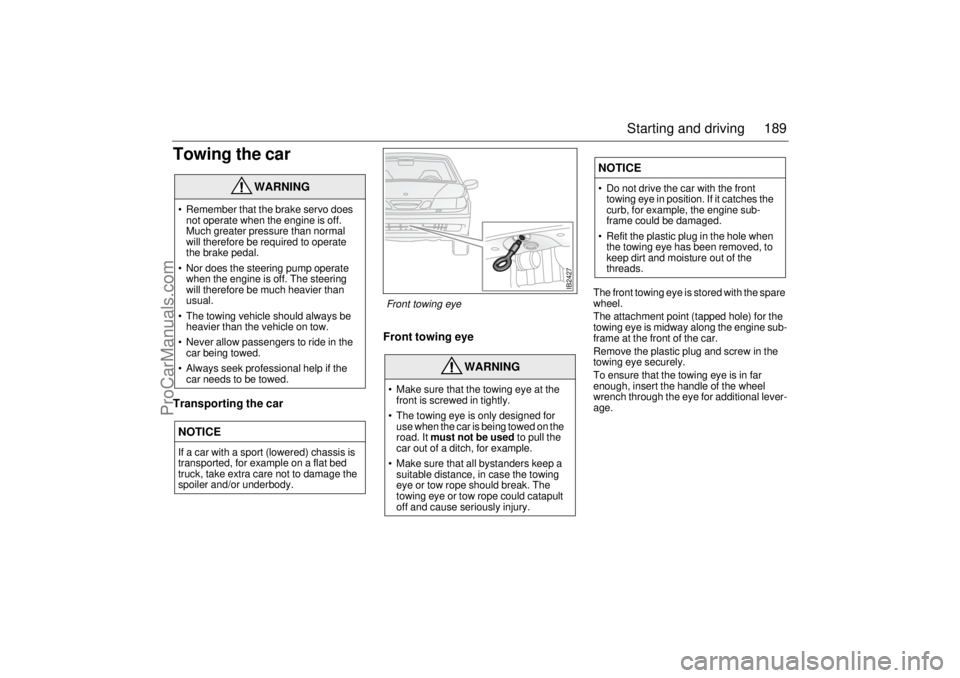
189 Starting and driving
Towing the carTransporting the car Front towing eye
The front towing eye is stored with the spare
wheel.
The attachment point (tapped hole) for the
towing eye is midway along the engine sub-
frame at the front of the car.
Remove the plastic plug and screw in the
towing eye securely.
To ensure that the towing eye is in far
enough, insert the handle of the wheel
wrench through the eye for additional lever-
age.
WARNING
Remember that the brake servo does
not operate when the engine is off.
Much greater pressure than normal
will therefore be required to operate
the brake pedal.
Nor does the steering pump operate
when the engine is off. The steering
will therefore be much heavier than
usual.
The towing vehicle should always be
heavier than the vehicle on tow.
Never allow passengers to ride in the
car being towed.
Always seek professional help if the
car needs to be towed.NOTICEIf a car with a sport (lowered) chassis is
transported, for example on a flat bed
truck, take extra care not to damage the
spoiler and/or underbody.
WARNING
Make sure that the towing eye at the
front is screwed in tightly.
The towing eye is only designed for
use when the car is being towed on the
road. It must not be used to pull the
car out of a ditch, for example.
Make sure that all bystanders keep a
suitable distance, in case the towing
eye or tow rope should break. The
towing eye or tow rope could catapult
off and cause seriously injury.
NOTICE Do not drive the car with the front
towing eye in position. If it catches the
curb, for example, the engine sub-
frame could be damaged.
Refit the plastic plug in the hole when
the towing eye has been removed, to
keep dirt and moisture out of the
threads.
IB2427
Front towing eye
ProCarManuals.com
Page 248 of 288

248 Car care and technical information4Inspect the undercoating and touch
up if necessary.
Pay particular atten-
tion to the fenders and wheel housings,
which are exposed to abrasion by flying
gravel, etc. If the composition has worn
or flaked off, the steel must be thor-
oughly cleaned and dried before a fresh
coat is applied. The cleaning is best
done with a scraper and a steel wire
brush, followed by washing with solvent.
Apply the new coating thinly, as other-
wise it may run off or fall off when dry.
For long tripsBefore setting off on a long journey, it is
advisable to have your car checked over by
your Saab dealer.
Obtain a few important items to take along
on your journey such as spare bulbs, wiper
blades, fuses, a Poly-V-belt and the like.
You can check some points yourself before-
hand:
Make sure that the engine is in good con-
dition.
Check that no oil or gasoline leaks out of
the engine or gearbox/transmission.
Check the coolant and power steering
fluid levels. Check also for leaks.
Inspect the Poly-V-belt and replace it if it
shows any signs of hard wear.
Check the battery charge.
Check the tires for tread pattern and air
pressure, including the compact spare
wheel.
Check the brakes.
Check all bulbs.
Check for the presence of the tool kit and
the jack in the car.
Recovery and/or
recycling of automotive
materialsA typical car consists of metals (65–75 %),
plastics (10–15 %), rubber (5 %) and small
quantities of glass, wood, paper and tex-
tiles. The recycling of metals has been com-
monplace for a long time now.
To facilitate sorting of other materials for
recycling, plastic parts, for instance, have
been marked to identify the precise nature
of the plastic.
The quantity of materials in the car that can
be recycled or recovered depends on the
scrapping facilities in different countries. EU
legislation that comes into force in 2006 will
require a minimum of 85 % of the total
weight of materials to be recycled. How-
ever, every major car salvage yard in each
market will receive details from Saab of how
the highest percentage of materials can be
reclaimed.
ProCarManuals.com
Page 262 of 288

262 Specifications
Engine variants
Viscosity
:
The viscosity of oil is classified according to the SAE standard.
Nowadays, multigrade oils are always used in cars. The proper-
ties of these oils facilitate starting the car in cold weather but
mean that the oil is also viscous enough to coat al moving parts
under high pressures and with high outside air temperatures.
Multigrade oils are graded with two viscosity’s, e.g. 5W-30,
where 5W meets certain viscosity requirements at –4°F (–20°C),
while 30 fulfils requirements at 212°F (100°C).
Oil capacity incl. filter (on changing):
4-cylinder _______________________ 4.1 qts (4.0 litres)
3.0t V6 _________________________ 4.6 qts (4.5 litres)
2.3t Ecopower Rating, EEC at 5500 rpm ____________ 185 hp (136 kW)
Maximum torque, EEC at 1800 rpm ____ 206.5 ft.lb
(280 Nm)
Compression ratio _________________ 9.3:1 2.3 Turbo Ecopower (”Aero” model engine) Rating, EEC at 5300 rpm ____________ 250 hp (184 kW)
Maximum torque, EEC at 1900 rpm 258.0 ft.lb.
(350 Nm)
Compression ratio _________________ 9.3:13.0t V6 Ecopower Rating, EEC at 5000 rpm ____________ 200 hp (147 kW)
Maximum torque, EEC at 2500 rpm ____ 229 ft.lb
(310 Nm)
Compression ratio _________________ 9.5:1
ProCarManuals.com
Page 275 of 288

275 Index
Light switches
___________________ 71
Luggage-compartment lighting
_____ 134
MMain instrument panel
_____________ 56
Main/dipped beam
_______________ 71
Maintenance schedule ___________ 254
Manual gearbox, technical data
____ 264
Maxi fuses
_____________________ 227
Milometer ______________________ 62
Motoring abroad
________________ 248
NNight Panel
_____________________ 69
OOil capacity, engine
______________ 260
Oil change, engine ______________ 204
Oil specification
_________________ 260
OnStar
________________________ 111
Outdoor temperature
______________ 65
Owner assistance
_______________ 255
PPaintwork, touching-in
____________ 245
Parking Assistance
______________ 193
Parking lights
___________________ 71
Plates and labels ________________ 269
Poly-V-belt
____________________ 211
Power steering _________________ 208Power-steering fluid
_____________208
Pressure gauge
__________________64
Programming I, ACC
______________83
Programming II, ACC _____________84
Programming the ACC ____________83
QQuestions on function of airbag
_____39
Quick guide, Audio System
_________91
RRadiator fan
____________________211
Radio
__________________________94
Rain sensor
_____________________75
Rear fog light ____________________72
Rear seat, 9-5 Sedan, folding
______139
Rear seat, 9-5 Wagon, folding _____142
Rear-seat head restraints
__________16
Rear-view mirror, antidazzle _______129
Rearview mirrors
________________125
Reclamation
___________________248
Recommendations for cars with
automatic transmission,
towing a caravan or trailer
________182
Refuelling
_____________________158
Relay panel ____________________229
Remote control __________________42
Remote-control battery, changing
____45
Remove the key
________________152
Reporting safety defects
__________256
Reprogramming of systems _______271Reservoir, power-steering fluid
____ 208
Rev counter
____________________ 62
Reversing lights
_________________ 74
Roof load
_____________________ 185
Running-in ____________________ 178
SSID
__________________________ 65
Saab 9-5 Audio System
___________ 89
Saab Information Display (SID)
_____ 65
Saab Parking Assistance
________ 193
Safety belts
____________________ 17
Safety belts, care of
_____________ 243
Safety-belt pretensioners
_________ 18
Safety-belt reminder
_____________ 17
Seats
_________________________ 12
Securing a load
_________________ 46
Selector lever indication,
automatic transmission
__________ 65
Sentronic, manual mode _________ 167
Service costs
__________________ 255
Service information
_____________ 256
Service intervals
_______________ 254
Service record retention
_________ 255
Settings, seats
__________________ 12
Side airbags
___________________ 36
Signalling, horn ________________ 124
Sliding floor, 9-5 Wagon
_________ 147
Snow chains
__________________ 179
Spare wheel __________________ 236
Spare wheel and tools
___________ 149
Spark plugs
___________________ 263
ProCarManuals.com
Page 276 of 288

276 IndexSpeed rating
___________________ 232
Speedometer _______________ 62
, 63
Starting in cold weather, ACC
_______ 83
Starting in hot weather, ACC _______ 83
Steering wheel adjustment
________ 124
Steering, technical data
__________ 265
Stone-chip damage, repairing
______ 245
Storage compartments
___________ 136
Sun visors
_____________________ 135
Sunroof
_______________________ 132
Suspension
____________________ 265
Suspension, technical data
________ 265
Switches
_______________________ 71
Symbols _______________________ 10
Systems, adjustment
_____________ 271
TTCS OFF
_______________________ 61
Table of fuses
__________________ 228
Tachometer
_____________________ 62
Tailgate, opening
________________ 46
Tank gauge
_____________________ 63
Technical data __________________ 257
Telematics
_____________________ 111
Temperature control, ACC
_________ 79
Temperature gauge, engine ________ 63
Temperature zones, ACC
__________ 79
Textile carpeting
________________ 243
Through-load hatch ______________ 141
Tie Downs
_____________________ 141
Tightening torque, wheel studs
_____ 237
Tip, driving at night
______________ 186Tip, to avoid theft
________________195
Tire markings
_____________ 232
, 233
Tire pressure
______________ 187
, 232
Tires
____________________ 232
, 267
Tires, winter
____________________266
Tools
_________________________149
Touching-in the paintwork
_________245
Towbar attachment
______________181
Towbar load
___________________184
Towing the car __________________189
Towing, automatics
______________189
Traction
_______________________175
Trailer weights
__________________259
Trionic
________________________201
Trip computer
___________________65
Trip meter
______________________62
Trunk
_________________________139
Trunk lid, opening
________________46
Turbo gauge
____________________64
Turbo, points to note
_____________155
UUnder the hood, 3.0t V6
__________200
Under the hood, 4-cyl
____________199
Upholstery and trim
______________243
Upholstery and trim, care of
_______243
Useful tips, ACC
_________________85
VVanity mirrors
__________________135
Ventilated front seats
_____________15
Viscosity, engine oil
______________260
WWarning labels
___________________ 8
Warning light, AIR BAG
___________ 38
Warning lights
__________________ 56
Washers
_____________________ 212
Washers, windshield
____________ 213
Washing the car
_______________ 244
Waxing and polishing
___________ 245
Wear indicators, tires ____________ 234
Wheel, change
________________ 237
Wheels and tires ___________ 232
, 267
Wheels and tires, sizes
__________ 266
Window glass sensor, car alarm
____ 49
Windshield washers
_____________ 75
Windshield wipers
_______________ 75
Winter tires
___________________ 266
Wiper blades, replacing
__________ 212
Wipers and washers
_________ 75
, 212
ProCarManuals.com